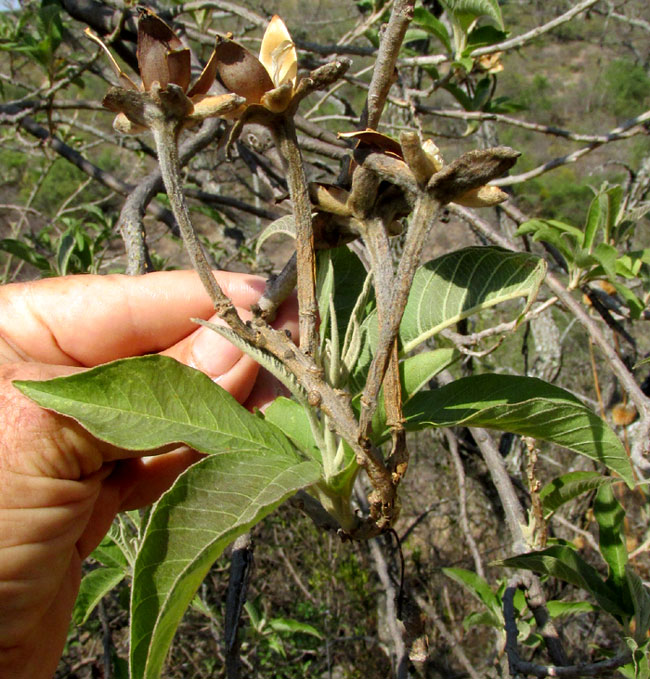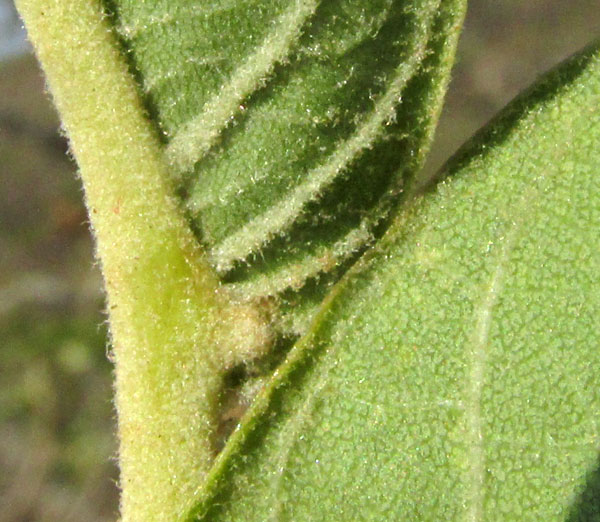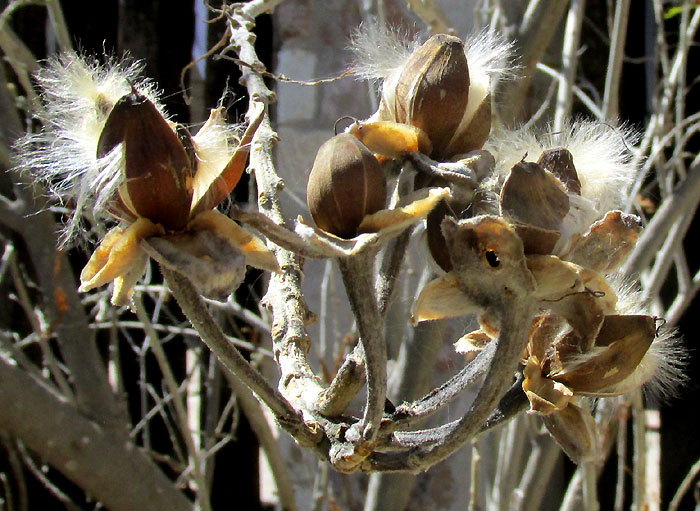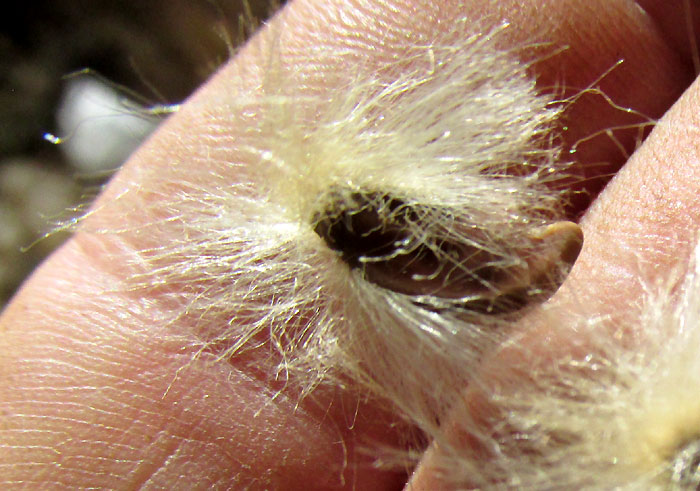Excerpts from Jim Conrad's
Naturalist Newsletter
entry dated May 21, 2022, notes from a camping trip among hills about 7kms ENE of Tequisquiapan, Querétaro state, MÉXICO
elevation about 2000m (6600 ft), near N20.57°, W99.85°
CAZAHUATE, "TREE MORNING GLORY"

At the hot, dusty, glaringly sunny end of the dry season, the landscape here is mostly brown and gray. However, in anticipation of the rainy season, a few shrubs and small trees already are issuing new growth. That was the case with a tree beside a narrow road snaking through the valley north of La Huiguera. However, it wasn't the new growth that caught my eye, but rather the flower-like remains of one of the tree's capsular-type fruits from last season, shown above.
In that picture, most of last season's flower and resulting fruit are long gone. However, at the bottom of the above structure, the flower's dried-out, leathery, hairy-bottomed sepals remain. Above the sepals, the four large, shiny, narrowly oval items are parts of the former fruit's husk-like walls, which split apart to release seeds. The crumpled, papery item in the center is the remains of thin walls separating compartments inside the former fruit, the endocarp, something like the flaky things between seeds in an apple core. The whole structure in the picture is about 45mm across (1¾ inch).
Three or four such fruit remains arose at the tips of many of the tree's branches:

The newly emerging leaves were soft and hairy, better seen below:

Above, notice the pimple-like gland growing at the base of the veiny leaf on the picture's left side. Such glands may repel insects climbing the stem to eat the leaves, or attract insects such as ants who may attack anyone wanting to nibble the leaf.
All the above features are interesting, but lacking the flowers, seeds, and more information about the fresh fruit, can we hope to identify this tree? One last important field mark for this species is shown below, the tree itself:

The tree is about 4.5m tall (15ft), which isn't big for a tree, but what kind of tree of this size might bear the fruiting structures and leaves documented above? Probably I'd have been stumped, but for certain vines met in the Yucatan, particularly a species called the Wood Rose. Our little tree's fruiting structures are suggestive of wooden roses. But, the Wood Rose plant was a vine...
However, a very few species of the big Morning-Glory Family, the Convolvulaceae -- about 1650 species in 58 genera -- are woody and tree forming. In the Yucatan we had one forming a woody bush, often referred to the Tree Morning-Glory, but that was a bush, not a tree.
It turns out that here we have a real morning-glory tree of the Morning-Glory Family, IPOMOEA MURUCOIDES, reported to reach 8-13m tall (26-43ft). It's native just to dry scrub and open tropical deciduous woodlands from here in central Mexico, south well into Guatemala, at 600-2400m in elevation (1900-7900ft). It doesn't appear to have a recognized English name, and the name Morning-Glory Tree is taken by another species. In Spanish it's often called Cazahuate, and sometimes English-speaking botanists just use that.
Of the small group of woody morning-glories known, our Ipomoea murucoides is distinguished not only by its height but also by its dense, white hairiness, its flowers' particularly large sepals, and the broad leaf bases.
In much of Mexico Ipomoea murucoides is considered both toxic and medicinal. Cows shouldn't eat it, but traditionally mashed leaves and flowers are variously used to make plasters to cover body parts that are hurting, inflamed or infected. An infusion of the leaves and flowers has been used to keep hair from falling out. Some people drink an infusion of the flowers for scorpion stings.
Also, the famously edible Oyster Mushroom, Pleurotus ostreatus is reported by Professor Mario Rojas Ala in Morelos to favor growing at the trunk of these trees.
entry from field notes dated January 17, 2023, taken on trail up the southeast-facing slope of Peña de Bernal on the northwestern side of Bernal, elevation ±2,220m (7280 ft); bedrock of intrusive, igneous granodiorite, similar to granite; Querétaro state, MÉXICO, (N20.748°, W99.949°)
TREE MORNING GLORY SEEDS

Above, pods are splitting, releasing seeds. Here's one seed:
